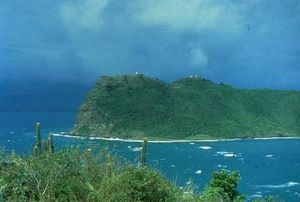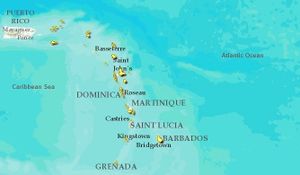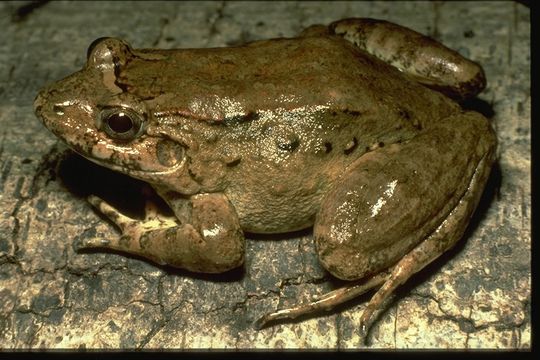Windward Islands xeric scrub
In contrast to the Leeward Islands that form the north half of the Lesser Antilles, the Windward Islands are characterized by a sharp topographic relief, high annual rainfall, large swaths of moist forest, and limited areas of dry, scrub habitat. This Windward Islands xeric scrub ecoregion, due to its limited size and proximity to thecoastal zone, is particularly vulnerable to human-caused alteration and disturbance. Areas such as Barbados and the western coast of Dominica suffer from a relatively high human population and extensive agricultural development: circumstances that bring associated problems such as introduced alien species and habitat alteration. Notable endemic species in this ecoregion are the Grenada Dove (Leptotila wellsi) and several reptile taxa characteristic of dry, low elevation xeric scrub habitat. Most of the present conservation focus is on the more elevated forest areas of the Windward Islands; however, it is this scrub ecoregion that is suffering the highest direct pressure from human population growth (Human population explosion) and development.
Location and general depiction
This ecoregion represents the drier, low elevation, areas of islands in the Caribbean’s Windward Islands and Barbados to the east. Specifically, xeric scrub habitat can be found on the entirety of Barbados, and coastal portions of Trinidad (Trinidad and Tobago), Grenada, St. Lucia, Martinique, and Dominica.
The Windward Islands extend southward from 15° 45' to 11° 45' N and from 60° 45' to 62° 00' W. They are west of Barbados and northwest of Trinidad and Tobago. From south to north, the islands are: Grenada, the Grenadines, St. Vincent, St. Lucia, Martinique, and Dominica.
The Windward Islands lie within the tradewind belt and lie upwind, in terms of the prevailing southeasterly wind, of the Leeward Islands. The rainy season occurs in summer and fall. Hurricanes and tropical storms batter these islands during this autumnal period. The interior highlands of the larger islands also receive rainfall in the drier winter months and additional amounts in the summer months. Annual rainfall in the interior highlands ranges from 10,000 millimetres (mm) in Dominica to 3750 mm for the lower elevation mountains in Grenada. Coastal areas that comprise much of the Xeric Scrub habitat receive lesser amounts ranging from 1000 mm on Dominica to 1600 mm at the southern end of St. Vincent.
The Windward Islands form a volcanic island arc. Lava flows, ash, and pyroclastic deposits ranging from Miocene to recent in age are the principal bedrock found in these islands. Some limestone formations are interspersed between the volcanic layers. In general, Grenada, the Grenadines, and St. Vincent are composed of basalts and basaltic andesites. Typically, lava flows outcrop on the steeper slopes and ash underlies the gentler slopes. St. Lucia, Martinique, and Dominica are predominantly composed of acid andesite and dacitic rocks. Pyroclastic flow deposits, volcanoclastics, and lava domes are typical for these islands. Characteristic soils in the ecoregion are alluvial and shoal while montmorillonitic clay is commonly found on the western slope of Dominica.
The vegetation of this ecoregion is seral in character with an adaptation to xeric conditions and low soil fertility. The extent and development of vegetation along the beaches depends on the width and elevation of the beach and the extent of interference by man. Commonly found larger flora are Broadleaf Lancepod (Lonchocarpus pentaphyllus), Black Mampoo (Pisonia fragrans), Longwood (Haematoxylon campechianum), Smooth Star Apple (Chrysophyllum argenteum), Erythroxylum ovatum and two species of cactus: Sweet Prickly-pear (Opuntia stricta var. dillenii) and Royen's Tree Cactus ( Pilosocereus royenii). In Barbados, sugar cane (Saccharum officinarum) cultivation dominates with plantations occupying nearly 28 percent of the land area. In the Windward Islands, xeric scrub occurs chiefly in areas with high coastal human population densities and concomitant agricultural development. As a result, this ecoregion is particularly susceptible to anthropogenic alteration and degradation.
Biodiversity
Due to the high proportion of tropical forest on the Windward Islands, there is high floral and faunal diversity. However, relatively little is unique to the small proportion of xeric scrub habitat found in this part of the Lesser Antilles. The most important plant component of this Ecoregion is represented by several species of Cactaceae which act as important food and cover resources for local fauna. There are a total of 228 vertebrate species that have been recorded in this ecoregion.
Mammals
Most of the native mammals occuring in the Windward Islands xeric scrub are bat taxa. Example species found here are: Lesser Naked-backed Bat (Pteronotus davyi); the Dominican Myotis (Myotis dominicensis VU); Trinidad Dog-like Bat (Peropteryx trinitatis).
Amphibians
There are six species of amphibians that are native to the ecoregion: the Mountain Chicken Frog (Leptodactylus fallax CR); Johnstone's Whistling Frog (Eleutherodactylus johnstonei); Lesser Antilles Robber Frog (Pristimantis urichi EN); Martinique Robber Frog (Eleutherodactylus martinicensis NT); Red Snouted Treefrog (Scinax ruber); and Whistling Frog (Leptodactylus wagneri);
Reptiles
Barbados has the greatest amount of faunal endemism within this ecoregion owed partly to its relatively large area, especially with regard to reptiles. The Barbados Anole (Anolis extremus) is a reptilian example. This anole is ubiquitous and has adapted well to human presence. Other endemic lizards include theGuyana Kentropyx (Kentropyx borckiana), a species that reproduces by parthenogenesis and consists of only females; and the Barbados Leaf-toed Gecko (Phyllodactylus pulcher.). The single endemic colubrid Barbados Racer (Liophis perfuscus) has a very restricted distribution in the mesic hilly, extreme east central portion of Barbados, which is relatively mongoose free and apparently not adversely affected by sugar cane production. However, this snake species is likely extinct, since it has not been observed for a considerable time. Crocodiles are not indigenous to the Lesser Antilles. The Spectacled Caiman (Caiman crocodylus), a Central and South American native, is apparently an occasional vagrant to the Grenadines.
Birdlife
The only bird endemic to the Windward Islands xeric scrub ecoregion is the Grenada Dove (Leptotila wellsi) that can be found in mature dry scrub lowlands and hillsides. It appears to favor a mixture of closed canopy, dense scrub and large areas of bare ground that can be found along the southern coast of Granada. All nonvolant mammals found in the Windward Islands are previously introduced by Amerindian or European settlers. Rodents, feral goats, pigs and opossums have exerted a major adverse impact on native vegetation and fauna. There are no extant endemic rodents in the Lesser Antilles. The introduction of the mongoose, originally introduced to control rodents and Pit Vipers (Bothrops), more than any other single factor, is correlated with the extirpation or extinction of reptile populations in the West Indies and particularly the small islands of the Lesser Antilles.
Ecological status
The small size and limited resources of the Windward Islands of the Lesser Antilles, in relation to the human populations, have created serious problems of resource depletion and exploitation. Many of the Windward Islands are characterized by rugged topography that significantly constrains human settlements and agricultural development. As a result, human populations are highest in coastal areas. Several of these areas are comprised of Xeric Scrub habitat and fall within this Ecoregion. A typical example is Dominica where 70% of the island’s population lives on the flatter, western (leeward) side of the island.
Threat profile
The two most salient threats to this ecoregion are the loss of natural habitat and the introduction of alien species. These areas have suffered a long history of environmental degradation, chief among them the cultivation of tobacco and sugar-cane. Barbados is perhaps the most extreme example having been under cultivation for nearly three centuries, leaving little natural vegetation. A more recent threat, with the advent of the tourism industry, is the construction of hotels and related infrastructure at the expense of natural habitats. Introduced animals continue to have a profound negative effect on the native fauna throughout the Lesser Antilles. The Mongoose (Herpestes auropunctatus), feral cats, and in some locations, rats (Rattus spp.) continue to prey on numerous lizard and snake species, while domestic goats have a significant effect on vegetation, particularly in small xeric habitats.
Justification of ecoregion delineation
This xeric scrub ecoregion of the Windward Islands was designated according to various CCA survey reports. In order to maintain our broad scale coverage we lumped their classifications of "cactus scrub terrestrial life zones" from all of the Windward Island which contained this habitat type. Littoral vegetation was also included, when bordering cactus scrub formations.
References
- Eric Dinerstein; David Olson; Douglas J. Graham; et al. (1995). A Conservation Assessment of the Terrestrial Ecoregions of Latin America and the Caribbean. World Bank, Washington DC.
- M.A. Iturralde-Vinent and R.D.E. MacPhee (1999). Paleogeography of the Caribbean region: Implications for Cenozoic biogeography. Bulletin of the American Museum of Natural History, 238:1-95.
- David Lewis Lentz. 2000. Imperfect Balance: Landscape Transformations in the Precolumbian Americas. Columbia University Press
- R.D.E. MacPhee, Ronald Singer, Michael Diamond (2000). Late Cenozoic Land Mammals from Grenada, Lesser Antilles Island-Arc. American Museum Novitates Number 3302, American Museum of Natural History, October 16, 2000.
- January Rogozinski (1999) A Brief History of the Caribbean: From the Arawak and Carib to the Present ISBN 0-8160-3811-2
- Jonathan Roughgarden. 1995. Anolis Lizards of the Caribbean : Ecology, Evolution, and Plate Tectonics: Ecology, Evolution, and Plate Tectonics. Oxford University Press (Google eBook) ;
| Disclaimer: This article contains some information that was originally published by the World Wildlife Fund. Topic editors and authors for the Encyclopedia of Earth have edited its content and added new information. The use of information from the World Wildlife Fund should not be construed as support for or endorsement by that organization for any new information added by EoE personnel, or for any editing of the original content. |


